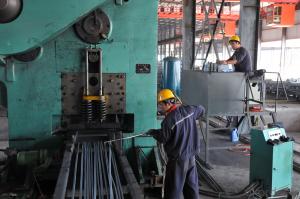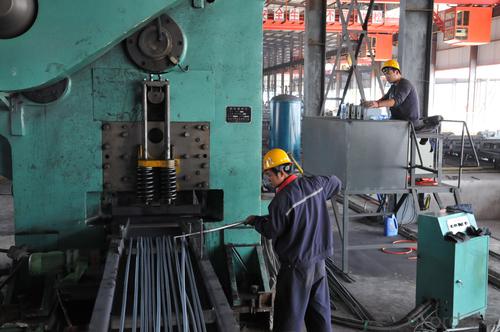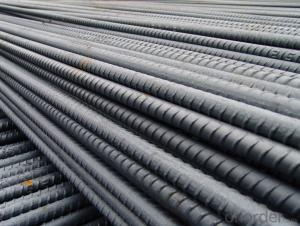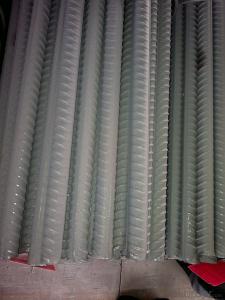Reinforcing Steel Bar for Concrete
- Loading Port:
- China Main Port
- Payment Terms:
- TT or LC
- Min Order Qty:
- -
- Supply Capability:
- -
OKorder Service Pledge
OKorder Financial Service
You Might Also Like
Product Description:
OKorder is offering Reinforcing Steel Bar for Concrete at great prices with worldwide shipping. Our supplier is a world-class manufacturer of steel, with our products utilized the world over. OKorder annually supplies products to African, South American and Asian markets. We provide quotations within 24 hours of receiving an inquiry and guarantee competitive prices.
Product Applications:
Reinforcing Steel Bar for Concrete are ideal for structural applications and are widely used in the construction of buildings and bridges, and the manufacturing, petrochemical, and transportation industries.
Product Advantages:
OKorder's Reinforcing Steel Bar for Concrete are durable, strong, and wide variety of sizes.
Main Product Features:
· Premium quality
· Prompt delivery & seaworthy packing (30 days after receiving deposit)
· Can be recycled and reused
· Mill test certification
· Professional Service
· Competitive pricing
Product Specifications:
Manufacture: Hot rolled
Grade: HRB335
Size: 6mm-25mm
Certificates: ISO, SGS, BV, CIQ
Length: 6m – 12m, as per customer request
Packaging: Export packing, nude packing, bundled
| DEFORMED BAR | |
| SIZE d(mm) | theoretical kg/m |
| 6 | 0.222 |
| 8 | 0.395 |
| 10 | 0.617 |
| 12 | 0.888 |
| 14 | 1.21 |
| 16 | 1.58 |
| 18 | 2 |
| 20 | 2.47 |
| 22 | 2.98 |
| 25 | 3.85 |
| 28 | 4.83 |
| 32 | 6.31 |
Grade | Technical data of the original chemical composition (%) | |||||||
C | Mn | Si | S | P | B | |||
HRB335 | ≤0.25 | ≤1.60 | ≤0.80 | ≤0.045 | ≤0.045 | >0.0008 | ||
Physics capability | ||||||||
Yield Strength(N/cm2) | Tensile Strength(N/cm2) | Elongation (%) | ||||||
≥335 | ≥490 | ≥16 | ||||||
Grade | Technical data of the original chemical composition (%) | |||||||
C | Mn | Si | S | P | V | |||
HRB400 | ≤0.25 | ≤1.60 | ≤0.80 | ≤0.045 | ≤0.045 | 0.04-0.12 | ||
Physics capability | ||||||||
Yield Strength(N/cm2) | Tensile Strength(N/cm2) | Elongation (%) | ||||||
≥400 | ≥570 | ≥14 | ||||||
FAQ:
Q1: Why buy Materials & Equipment from OKorder.com?
A1: All products offered byOKorder.com are carefully selected from China's most reliable manufacturing enterprises. Through its ISO certifications, OKorder.com adheres to the highest standards and a commitment to supply chain safety and customer satisfaction.
Q2: How do we guarantee the quality of our products?
A2: We have established an advanced quality management system which conducts strict quality tests at every step, from raw materials to the final product. At the same time, we provide extensive follow-up service assurances as required.
Q3: How soon can we receive the product after purchase?
A3: Within three days of placing an order, we will arrange production. The normal sizes with the normal grade can be produced within one month. The specific shipping date is dependent upon international and government factors, the delivery to international main port about 45-60days.
Images:
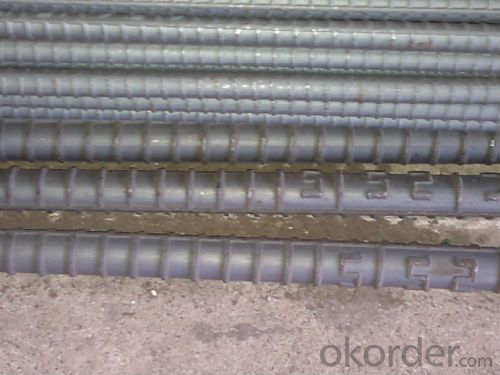
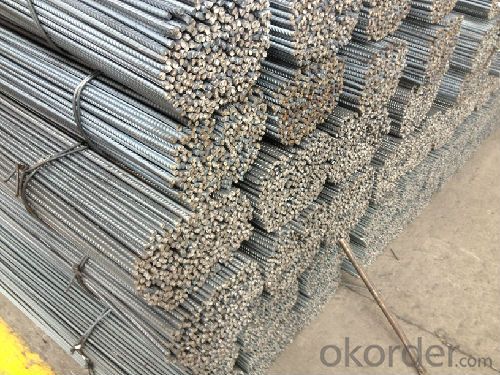
- Q: What are the guidelines for the proper spacing of steel rebars in slabs-on-grade?
- To ensure the structural integrity and longevity of the concrete slab, it is crucial to follow guidelines for spacing steel rebars in slabs-on-grade. Here are the general guidelines to be followed: 1. Concrete cover: The first consideration is the distance between the rebar surface and the concrete edge, known as the concrete cover. Local building codes or engineering standards typically specify the minimum cover requirements, which must be strictly adhered to. This cover protects the rebar from corrosion and provides fire resistance. 2. Rebar spacing: The spacing between rebars depends on the load requirements and slab dimensions. A closer spacing results in a stronger slab. However, it is necessary to maintain proper spacing to allow free flow of concrete around the rebar during pouring and ensure proper consolidation. Generally, the spacing should not exceed three times the slab thickness or 18 inches, whichever is smaller. 3. Rebar size and diameter: The selection of rebar size and diameter depends on the load requirements and design specifications. Larger loads require larger diameter rebars with increased spacing. Common rebar sizes for slabs-on-grade range from #3 (3/8 inch diameter) to #8 (1 inch diameter). 4. Rebar placement: Proper placement of rebars within the slab is critical. The rebars should be positioned at the center of the slab's thickness to ensure even load distribution. Moreover, they should be securely tied or supported to prevent displacement during concrete placement and consolidation. 5. Joint reinforcement: Construction joints are often included in slabs-on-grade to accommodate expansion and contraction. Proper reinforcement of these joints is essential for maintaining structural integrity. Joint reinforcement, such as dowel bars or tie bars, should be placed perpendicular to the joint and adequately anchored on both sides. It is important to note that these guidelines provide a general overview, and specific project requirements may vary. Consulting a structural engineer or following local building codes and industry standards is essential to ensure compliance and optimize the design of steel rebars in slabs-on-grade.
- Q: What is the recommended diameter of steel rebars for slab reinforcement?
- The recommended diameter of steel rebars for slab reinforcement typically ranges from 8mm to 32mm, depending on the specific requirements of the slab design and the expected load-bearing capacity.
- Q: Can steel rebars be used in the construction of residential buildings?
- Steel rebars are indeed suitable for the construction of residential buildings due to their strength and durability. When it comes to reinforced concrete structures, steel rebars are commonly utilized. Within residential construction, their primary purpose is to reinforce concrete foundations, beams, columns, and slabs. This reinforcement provides added support and enhances the structural integrity of the building, allowing it to withstand various loads and forces. Steel rebars are preferred over alternative materials due to their high tensile strength, resistance to corrosion, and ability to withstand extreme weather conditions. Furthermore, they are readily available, cost-effective, and can be customized to meet specific building requirements. Consequently, steel rebars play a vital role in the construction of residential buildings, ensuring their long-lasting stability and safety.
- Q: How do steel rebars perform in blast-resistant structures?
- Steel rebars perform well in blast-resistant structures due to their high tensile strength and ability to absorb and distribute the energy generated by a blast. The reinforcement provided by rebars helps to strengthen the concrete structure, minimizing the risk of collapse and enhancing the overall resilience of the building. Additionally, steel rebars can be designed and placed strategically to further enhance blast resistance, making them a crucial component in ensuring the safety and durability of such structures.
- Q: How do steel rebars contribute to the seismic performance of a structure?
- Steel rebars contribute to the seismic performance of a structure by enhancing its strength and ductility. When embedded in concrete, rebars act as reinforcement, providing tensile strength to resist the forces generated during an earthquake. This reinforcement helps prevent cracking and failure in the concrete, allowing the structure to better absorb and dissipate seismic energy. Additionally, the flexibility and high yield strength of steel rebars enable them to deform and absorb seismic forces, reducing the likelihood of structural collapse during an earthquake.
- Q: Can steel rebars be used in the construction of airports and terminals?
- Yes, steel rebars can be used in the construction of airports and terminals. Steel rebars are commonly used as reinforcement in concrete structures to provide strength and durability. In the construction of airports and terminals, where heavy loads and high traffic volumes are expected, the use of steel rebars is essential for ensuring the structural integrity of the buildings and runways.
- Q: What is the impact of steel rebars on the overall carbon footprint of a building?
- Steel rebars have a significant impact on the overall carbon footprint of a building. The production of steel involves high energy consumption and releases a substantial amount of greenhouse gas emissions, primarily carbon dioxide. The extraction and processing of iron ore, as well as the manufacturing and transportation of steel rebars, contribute to the carbon footprint of a building. The carbon footprint of steel rebars is further influenced by the extent of the rebar usage in the building. The more steel rebars used, the higher the carbon footprint will be. The size and complexity of the structure, as well as the specific design requirements, will determine the quantity of steel rebars needed. However, it is important to note that steel rebars are an essential component of reinforced concrete, which is widely used in construction due to its strength and durability. Reinforced concrete provides structural integrity and ensures the safety and longevity of a building. So, while steel rebars contribute to the carbon footprint, they also play a crucial role in constructing safe and resilient structures. To mitigate the carbon footprint associated with steel rebars, several strategies can be employed. One approach is to use recycled steel rebars, which significantly reduces the energy consumption and emissions associated with steel production. Additionally, optimizing the design and construction process can help minimize the overall amount of steel required, thereby reducing the carbon footprint. Moreover, alternative materials such as fiber-reinforced polymers (FRPs) are being developed as substitutes for steel rebars. FRPs have lower carbon footprints, as they are made from materials such as fiberglass or carbon fiber, which have lower emissions during production. However, the use of FRPs is still limited, and further research and development are needed to increase their viability as a mainstream alternative. In conclusion, steel rebars have a notable impact on the overall carbon footprint of a building due to the energy-intensive production process and emissions associated with their extraction, manufacturing, and transportation. However, their crucial role in providing structural integrity and durability must be considered. Efforts to reduce the carbon footprint of steel rebars include using recycled materials, optimizing designs, and exploring alternative materials such as FRPs. Ultimately, a holistic approach that considers both the environmental impact and the structural requirements of a building is necessary to minimize the carbon footprint associated with steel rebars.
- Q: What are the advantages of using epoxy-coated stainless steel rebars?
- Epoxy-coated stainless steel rebars offer a variety of benefits. Firstly, the addition of epoxy coating enhances the rebars' corrosion resistance by acting as a barrier against moisture, chemicals, and other corrosive elements. This extends the rebars' lifespan and ensures the durability of the structure. Secondly, the epoxy coating improves the bond strength between the rebar and concrete by creating a rough surface texture. This results in a stronger overall structure. Another advantage is that the epoxy coating provides a smooth surface, making the rebars easier to handle and install during construction. It also eliminates the risk of injury from sharp edges. Furthermore, epoxy-coated stainless steel rebars are environmentally friendly as they do not contain harmful substances like lead or heavy metals. This makes them a sustainable choice for environmentally conscious projects. Lastly, these rebars require minimal maintenance due to the protective layer provided by the epoxy coating. This saves time, costs, and minimizes disruptions to ongoing construction projects. In conclusion, the benefits of using epoxy-coated stainless steel rebars include enhanced corrosion resistance, improved bond strength, ease of handling and installation, environmental friendliness, and reduced maintenance requirements. These advantages make them a reliable and cost-effective choice for reinforcing concrete structures.
- Q: What is the bending radius allowed for steel rebars?
- The bending radius allowed for steel rebars typically depends on the specific grade and diameter of the rebar. However, as a general guideline, rebars with a diameter up to 25mm can typically be bent with a minimum bending radius of 4 times the diameter of the rebar.
- Q: What is the length and size of thread steel?
- Domestic sales of domestic thread steel, if the contract does not specify requirements, usually fixed length of 9m, 12m two length.
Send your message to us
Reinforcing Steel Bar for Concrete
- Loading Port:
- China Main Port
- Payment Terms:
- TT or LC
- Min Order Qty:
- -
- Supply Capability:
- -
OKorder Service Pledge
OKorder Financial Service
Similar products
Hot products
Hot Searches
Related keywords
